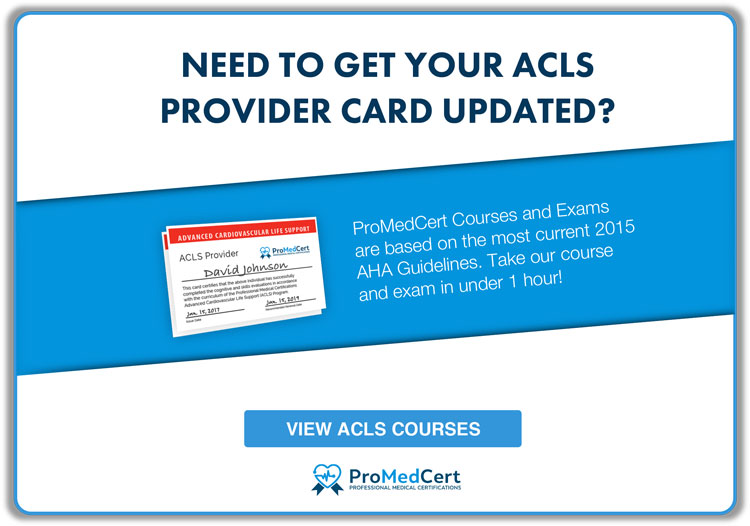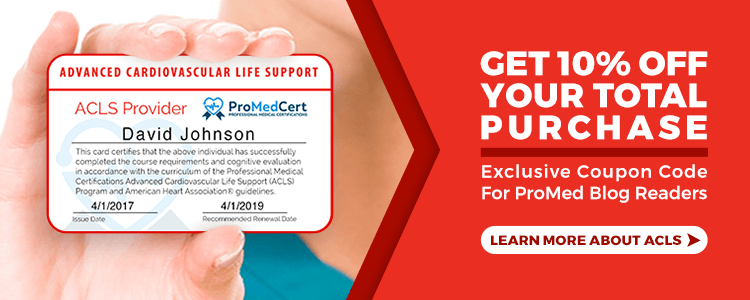2015 ACLS AHA Guidelines Update: Everything You Need To Know

The American Heart Association (AHA) Guidelines Update released in 2015 contains several changes in language and a few changes in technique that are specific to Cardiopulmonary Resuscitation (CPR) and Emergency Cardiovascular Care (ECC). These major updates occur every 5 years, so the next AHA Guidelines Update will be released in 2020.
For the 2015 updates, the AHA has recommended a focus on the most significant or controversial guideline recommendations, those that will result in change in resuscitation practice or training, and those that are associated with the science of resuscitation. We've outlined the updates that most heavily impact Adult Cardiac Life Support (ACLS), along with other updates you'll want to be aware of.
The Need-To-Know 2015 ACLS AHA Updates
-
Combined use of vasopressin and epinephrine is no longer recommended and vasopressin has been removed from the Adult Cardiac Arrest Algorithm 2015 Update. Vasopressin combined with epinephrine does not offer an advantage over standard-dose epinephrine in cardiac arrest. It has been removed from the Adult Cardiac Arrest Algorithm for simplicity.
-
Epinephrine can reasonably be administered as soon as it is feasible after the onset of cardiac arrest resulting from an initial nonshockable rhythm.
-
Consideration of low end-tidal carbon dioxide (ETCO2) is a parameter that should be considered in combination with other factors after 20 minutes of CPR when deciding to terminate resuscitation. ETCO2 < 10mm Hg is associated with a very low likelihood of resuscitation.
-
Providers can reasonably consider use of steroids bundled with vasopressin and epinephrine in treatment of IHCA. When treating IHCA, steroids may provide some benefit but they are not yet routinely recommended.
-
Extracorporeal CPR may be considered in some patients who are not resuscitated by conventional CPR. ECPR can prolong viability if it is implemented rapidly, so it may be considered for treatment of conditions that are potentially reversible or when arranging for a heart transplant. It is resource intensive and costly, so use should be limited to patients with a reasonably high likelihood of benefit.
-
Changes in Post-Cardiac Arrest Drug Therapy include guidance on use of lidocaine and beta blockers. Although there is inadequate evidence to recommend routine use of lidocaine after cardiac arrest, initiation or continuation may be considered immediately after return of spontaneous circulation from cardiac arrest due to VF or pulseless VT. Although there is inadequate evidence to support routine beta-blocker use after cardiac arrest, initiation or continuation may be considered early after hospitalization from cardiac arrest due to VF or pulseless VT.
-
Other Key Changes in Post-Arrest Cardiac Care include recommendations for:
-
emergency coronary angiography for all patients with ST elevation and for unstable patients without ST elevation but with suspicion of a cardiovascular lesion;
-
targeted temperature management for all comatose patients with ROSC after cardiac arrest should target temperatures between 32C and 36C for at least 24 hours; actively preventing fever in patients after targeted temperature management is reasonable;
-
routine prehospital cooling of patients with rapid IV infusion of cold IV fluid after ROSC is not recommended; hypotension should be avoided and immediately corrected during post-cardiac arrest care; prognostication should be delayed until at least 72 hours after completion of therapeutic hypothermia and no sooner than 72 hours after cardiac arrest and ROSC.
-
All patients who progress to circulatory or brain death after cardiac arrest should be considered as potential organ donors. The 2010 Guidelines suggest that patients with brain death should be considered organ donors.

-
Recommendations for changes in prehospital and emergency department care of patients with acute coronary syndrome include:
-
Interpretation of ECG by trained nonphysician providers to determine whether or not there is evidence of STEMI.
-
Consideration of prehospital transfer to a PCI center and immediate transfer of all adults presenting with STEMI in the ED of a hospital without PCI capabilities, without fibrinolysis.
-
Fibrinolytic therapy may be acceptable when immediate transfer for primary PCI is not available.
-
It may be reasonable to transfer STEMI patients early after fibrinolytic therapy, within 3-24 hours, compared to a transfer only for rescue PCI.
-
High sensitivity Troponin I measurements less than the 99th percentile measured at 0 and 2 hours can be used with stratification through the TIMI score (Thrombolysis in Myocardial Infarction) to predict a less than 1% chance of 30-day major adverse cardiac event. High sensitivity troponin T and I measurements should not be used to exclude the diagnosis of ACS.
-
Special Resuscitation Circumstances include patients with opioid overdose, use of intravenous lipid emulsion for treatment of local anesthetic systemic toxicity; and the importance of high quality CPR in pregnancy.
-
Opioid Overdose
-
Naloxone is recommended for administration by lay rescuers and healthcare providers.
-
Empiric administration may be reasonable as an adjunct to standard first aid and lay BLS protocols in patients with possible life threatening emergencies due to opioid associated overdose.
-
Patients with no definite pulse may be in cardiac arrest, or may have an undetectable pulse, and should be managed with standard resuscitation measures given priority over naloxone.
-
There should be no delay in seeking advanced medical care while awaiting a response to naloxone or other interventions.
-
Intravenous lipid Emulsion may be administered concomitant with standard resuscitative measures to patients with neurotoxicity or cardiac arrest as a result of local anesthetic toxicity and to patients with other forms of drug toxicity who are not responding to standard resuscitative protocols.
-
Pregnant women in cardiac arrest should receive high quality CPR and relief of aortocaval compression. For patients with a fundus at the level of the umbilicus or above, use of manual left uterine displacement may be beneficial during chest compressions to relieve aortocaval compression.
-
There is no reason for delay of perimortem caesarean delivery in cases of nonsurvivable maternal trauma or prolonged maternal pulselessness. Perimortem caesarean delivery should be considered at 4 minutes after onset of maternal cardiac arrest or after 4 minutes of resuscitative efforts in patients with unwitnessed arrest.
*Additional details on the guideline changes and supporting evidence can be accessed at this link: AHA Guideline Changes

